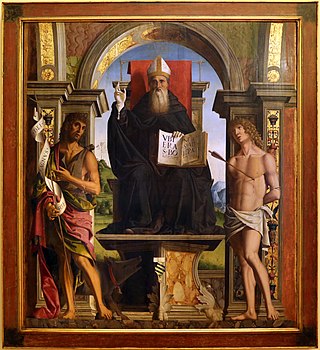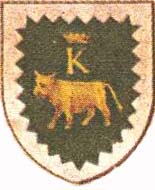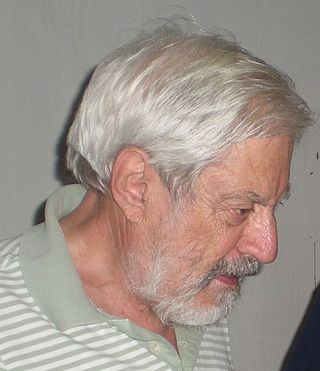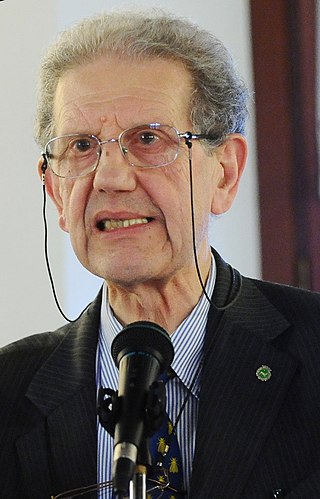
The Forlivese school of art was a group of Italian Renaissance painters and other artists. Most were born in Forlì or near it in the Emilia-Romagna region of Italy. Some other artists went to Forlì to study.

The House of Bove is an ancient noble patrician family of Ravello, Maritime Republic of Amalfi that held royal appointments in the Kingdom of Naples, and presided over feudal territories. After the dissolution of noble seats of the Kingdom of Naples in 1800 they were ascribed in the Libro d'Oro of Ravello. The Bove coat of arms is prominently displayed in the Duomo of Ravello.

Antonio Randa was an Italian painter of the classicist period, active in Ferrara, Modena, Rovigo, Florence, Comacchio and his native Bologna.

Alessandro Barbero is an Italian historian, novelist and essayist.
Eugenio Garin was an Italian philosopher and Renaissance historian. He was recognised as an authority on the cultural history of the Renaissance. Born at Rieti, Garin studied philosophy at the University of Florence, graduating in 1929, and after a period as professor of philosophy at the liceo scientifico Stanislao Cannizzaro in Palermo and the University of Cagliari, Garin began teaching at his alma mater in 1949 until 1974, then moving to the Scuola Normale di Pisa until his retirement in 1984. The Graduate School of Historical Studies at San Marino was inaugurated with a public lecture by Eugenio Garin on 30 September 1989. Garin was an elected member of both the American Philosophical Society and the American Academy of Arts and Sciences. He also was the editor of the journals Rinascimento and Giornale Critico della Filosofia Italiana.
The Acqui Award of History is an Italian prize. The prize was founded in 1968 for remembering the victims of the Acqui Military Division who died in Cefalonia fighting against the Nazis. The jury is composed of seven members: six full professors of history and a group of sixty (60) ordinary readers who have just one representative in the jury. The Acqui Award Prize is divided into three sections: history, popular history, and historical novels. A special prize entitled “Witness to the Times,” given to individual personalities known for their cultural contributions and who have distinguished themselves in describing historical events and contemporary society, may also be conferred. Beginning in 2003 special recognition for work in multimedia and iconography--”History through Images”—was instituted.

The church of Santi Severino e Sossio and the annexed monastery are located on via Bartolommeo Capasso in Naples, Italy.
Luigi Firpo was an Italian historian and politician.

Gaetano Cozzi was an Italian historian, professor at Padua University, and researcher with the Giorgio Cini Foundation and Fondazione Benetton Studi e Ricerche. He was a specialist in Venetian history, with special attention to the institutions, the relationship between law and society and the cultural environment.

Santa Croce alla Lungara is a church in Rome (Italy), in the Rione Trastevere, facing on Via della Lungara. It is also called Santa Croce delle Scalette', due to the presence of a double flight of stairs giving access from the street; or Buon Pastore, since in the 19th century the church and the annexed cloister were entrusted to the Sisters of the Good Shepherd of Angers.

Italo Insolera was an Italian architect, urban and land planner, and historian.
Studi sul Settecento Romano is an Italian yearly journal of art history, devoted in particular to the study of artistic and architectural culture in eighteenth-century Rome.
Claudio Zanier is an Italian historian specialising in the history of East Asia and South East Asia, and in the history of silk, in particular.
Lellia Cracco Ruggini was an Italian historian of Late Antiquity and professor emerita of the University of Turin. Her particular interests were in economic and social history, the history of ideas, and modern and ancient historiography. She specialized in the period from the second to seventh centuries AD.

Gustavo Frizzoni was an Italian art critic and art historian.

Chiara Frugoni was an Italian historian and academic, specialising in the Middle Ages and church history. She was awarded the Viareggio Prize in 1994 for her essay, Francesco e l'invenzione delle stimmate.

Salvatore Settis is an Italian archaeologist and art historian. From 1994 to 1999 he was director of the Getty Center for the History of Art and the Humanities in Los Angeles and from 1999 to 2010 of the Scuola Normale Superiore in Pisa.

Minerva between Geometry and Arithmetic is a 1550 fresco fragment, usually attributed to Paolo Veronese but by some art historians to Anselmo Canera or Giambattista Zelotti. It was painted for the Palazzo de Soranzi in Castelfranco Veneto but now in the Palazzo Balbi in Venice.
Gian Piero Brunetta is an Italian film critic, film historian, and academic.
The Tavola Strozzi is a painting made using tempera on wood and attributed to Francesco Rosselli, datable to 1472-1473 and kept in the National Museum of San Martino in Naples. It represents a view of Naples from the 15th century.











